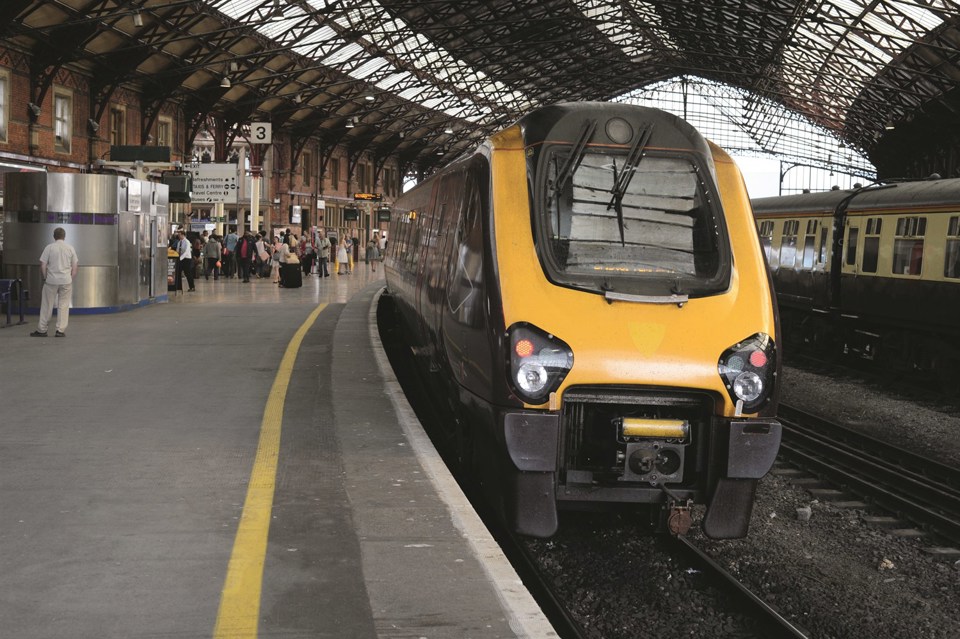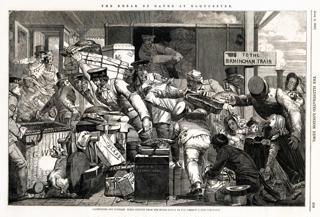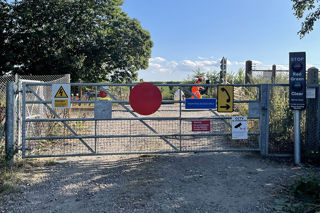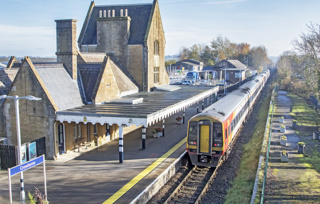Day 3
After an overnight stay in Bath, the day begins with breakfast on the hoof on board First Great Western’s 0900 to Bristol Temple Meads.
Sadly this isn’t a dining car - I’m propped up in the buffet, where I have bought a hot bacon baguette and Fairtrade coffee. The bacon is pretty good, but if it came to a battle of the baguettes FGW would have to wave a white flag in the face of Grand Central’s offering two days earlier, which was far crisper and firmer.
My perch is the ideal place to observe fellow travellers and staff, including the buffet attendant. Judging by his easy manner, laughing and joking with his customers, he obviously enjoys his job.
In the next car it’s not hard to spot some women off on a hen weekend - is it some bizarre legal requirement nowadays that the bride-to-be has to wear a veil and L-plates?
It is less easy to establish the cause of their raucousness - alcohol or adrenaline? Still, their antics keep me entertained as far as Bristol Temple Meads, where we all decamp - them to get drunk in town, and me to explore the station, which to my mind is a bit of a classic.
I pause to watch two train dispatchers ensuring a train’s right-time departure, by hurrying a bumbling pair of cyclists aboard. Afterwards the pair grumble about the poor attitude of British cyclists compared with their foreign cousins!
Unlike many stations Temple Meads has changed little in recent decades, apart from a reduction in status when the locomotive depot closed and mail trains ceased. But all that’s changing, now that electrification is on the way. Thankfully Brunel’s original 1840s station will soon see trains again, when it’s finally released from its shameful role as a Grade 1 listed car park to cope with a vast increase in passengers.
From Bristol I head north to Birmingham on a CrossCountry Voyager. It is a comfortable journey - the train is full, but the Class 220 is clean and my fellow passengers are well behaved. I spend most of the trip enjoying the view, while basking in the sunshine flooding through the windows.
The Voyager makes light work of the infamous Lickey incline. The only signs we are tackling a 1-in-37 gradient is a slight decrease in speed and a deeper engine noise as the motors work harder.
Leaving the train at Birmingham New Street, I set out to explore a station that is poles apart from Temple Meads. It’s hard to find kind words for a place that represents the worst of 1960s architecture, and the best I can come up with is “good riddance”!
But now the builders and bulldozers have moved in, as part of a £600 million project to turn the ugly duckling into a swan. No longer will travellers be treated as troglodytes, as natural light will be allowed to filter through a huge new atrium.
It’s very much a work in progress, so the mass of hoardings and jumble of new girders are harder to interpret than a Braille jigsaw. It won’t be until 2015 that you’ll be able to appreciate the results of all the hard work - in the meantime, trying to keep the station open for business throughout the rebuilding causes major challenges for builders and passengers alike.
I wander through the labyrinth, to join a scrum of people on a narrow platform waiting for a Derby train. As the CrossCountry ‘170’ rolls in, my heart sinks on seeing the rows and rows of paper seat reservations through the coach windows. In the end it isn’t a problem - most of the incumbents disembark, leaving plenty of space for those of us getting on.
However, my relief on securing a seat is short-lived when a young child decides to do its best to deafen everyone in the coach with constant crying and bawling, leaving me to take refuge in my iPod. The first bars of the track selected in shuffle mode cause a wry smile - The Who playing 5:15!
The music transports me to another world, and the 45-mile journey to Derby flies by. My one distraction is the sight of the Nemesis Rail depot at Burton on Trent, which appears to me like a valiant attempt at creating a diesel version of Barry scrapyard.
Arriving at Derby, my mood is lifted further when I recognise an old friend (but an unexpected face) working on the gateline - EMT’s Fleet Manager Jon Veitch. Many train operators have released senior staff to cover jobs on the frontline for the duration of the Olympics, and Jon has been allocated a variety of roles at Derby.
We chat for a while, and he regales me with stories of the tricks some of the more ‘inventive’ passengers have attempted to try to bluff their way through the gates. These entertaining yarns almost cause me to miss my connection, and I dive onto a northbound Voyager with seconds to spare.
Here I fire up my laptop to write my notes, and use the onboard WiFi to check emails. It may have taken CrossCountry a lot of prodding to install WiFi, but it’s pretty fast with a good range of flexible pricing options. It certainly keeps me busy for the duration of the trip to Sheffield, where I change trains again.
I am here to check out the station’s excellent Brewery Tap bar (it’s a tough job, but someone has to do it)! Even if you’re not a fan of real ale (and it has lots), it’s worth a look to appreciate the original tiling that lay forgotten for decades after the room was boarded up and abandoned by BR in the 1970s. Now it’s a busy pub that has expanded into adjacent rooms, bringing new life to the station.
Sheffield station is a favourite of mine. It combines sympathetic restoration of an old building, melded with the modern facilities expected by 21st century passengers.
I am working, so restrict myself to a half pint (just to check the beer quality, you understand) before moving on. I board a Northern Class 158 for Leeds. The unit itself is in good condition, but it is awash with litter despite the number of bins provided, leaving me to act as impromptu cleaner (I hate seeing trains in that condition).
We leave with few passengers aboard. But that changes when, with a squeal of wheels on rail, we pull into Meadowhall. A jumble of bag-bedecked people barge onto the train, and you could be forgiven for thinking: “Recession, what recession?” Sometimes I wonder if shopping isn’t the national pastime.
At this point the conductor carries out a ticket check. Many just give a cursory glance, but he has a gimlet eye and really scrutinises each ticket, giving me a knowing look when he saw my all-line Rover and camera!
Many of the shoppers leave us at Barnsley, a place where the bus and railway stations are combined in a new facility that opened in 2007. However, it’s not Barnsley I have come to see, it is our next stop, which many agree is (or rather was) Britain’s worst railway station… Wakefield Kirkgate.
That changes are afoot is obvious as soon as you arrive. The skeletal and glassless canopies on the island platform have vanished, with only some pillars remaining to hold a tracery of cabling and lights. A modern steel shelter survives, along with the spine wall that supports a canopy stopping the subway flooding. Over on the Leeds-bound platform new canopies are taking shape, while new subway entrances are on the ‘to do’ list, along with new passenger information systems.
The substantial three-storey station building remains boarded-up and derelict, although a consortium of Network Rail, Northern Rail, Grand Central, Wakefield Council, Railway Heritage Trust and Groundwork Wakefield has raised the £4.2m that will transform the area into space for new businesses, a café, a retail outlet with rail ticket sales, exhibition spaces, meeting rooms for community and local businesses, and accommodation for Groundwork Wakefield.
When the transformation is complete, the greatest blot on the railway’s landscape will have morphed into what I suspect will be an award-winning scheme. The only question that remains is: what’s the next slovenly station to inherit the unenviable crown that Kirkgate has worn for so long?
Saying goodbye to Wakefield, a Northern service carries me to Huddersfield, where I connect with a TransPennine Express train. As usual the Class 185 is full and standing (a graphic illustration of how extra capacity is desperately needed), so the recent announcement that the line will be electrified has been welcomed by everyone who uses it.
I am using it to visit what I consider to be the finest of our station pubs - the bar at Stalybridge station. It’s a real gem. It’s crammed with memorabilia, with wise-cracking staff and locals, and with a great range of liquid enticements - just plan your visit during the week, as it’s often heaving at weekends!
The famous trans-Pennine real ale trail is a victim of media exposure. Some of the pubs are struggling to cope with the hordes disgorged by weekend trains, and the atmosphere has changed as groups with no interest in real ale see it as an excuse for just another pub crawl.
I stay long enough for a pint, a chat with manageress Sylvia, and a gander at the new platforms being built as part of the Northern Hub scheme, before backtracking to Huddersfield for an experience of a different kind.
The (Northern Rail-sponsored) food and drink festival is held on the square outside the station, which forms a fantastic Grade 1-listed backdrop to the event. Rail is a vital component of the four-day festival, as thousands travel by train to sample what’s on offer. Many also go home by train, in this case on the 2127 Northern service to Leeds via Halifax. Despite the extra numbers travelling, I am disappointed to see no attempt is made to check tickets on board. No doubt Northern lost revenue that day because of it, as there are no barriers at Brighouse or Halifax.
Day 4
My Sunday starts by catching a train from Sowerby Bridge. Like many stations in the Calder Valley, it has an active ‘friends’ group that has raised money from ACoRP and sponsors to pay for the attractive floral displays brightening up the station. Northern has also been busy, installing new passenger information screens and a ticket machine to continue the improvements at what used to be a very basic station.
While waiting for my train to arrive I test the settings on a new gizmo I have brought along to add another dimension to my travels - a decibel meter to compare readings from different train interiors! I’m not claiming this will give definitive scientific readings, but hopefully it will produce some interesting results (more of which later).
West Yorkshire is the birthplace of the community railway movement, and many of the stations on the Calder Valley route benefit from having friends groups to look after them. They keep a watchful eye over them, clear litter, and decorate them with a profusion of flowers and all manner of murals.
A classic is Todmorden, birthplace of ‘incredible edibles’ - a scheme that has seen station planters sown with fruit and veg for anyone to harvest. The scheme’s success has spread to other stations - even Prince Charles has come to have a look.
Across the Pennines in Rochdale, developments have taken a more concrete turn, with a new flyover built to carry the Metrolink tram extension from Oldham into the town centre - something the former heavy-rail loop service could never hope to do. Both these towns are in desperate need of economic regeneration, and I’m looking forward to seeing what Metrolink will achieve when the route opens fully in 2014.
Somewhere else in need of regeneration is my next destination - Manchester Victoria. Despite grand plans and money being allocated, there’s precious little sign of progress, and the place remains a depressing dumping ground of architectural styles, from elegant Victorian to modern neo-brutalism. If anywhere should inherit Kirkgate’s vacant crown, this place must be a strong contender.
I don’t hang around, staying just long enough to catch an onward connection to Wigan Wallgate, on a deserted Northern Class 156.
As someone who remembers the route from the early 1970s, it generates mixed feelings. Then it was a complex network of tracks and yards, with sidings serving power stations and collieries, all of which have vanished. My mind’s eye plays tricks as it tries to reconcile the memory with the present-day realities. Salman Rushdie’s observation that “the past is another country” seems very appropriate.
I am brought back to the present when my train calls at Hindley, where (despite the rain) volunteers are busy mowing the station garden and clearing the undergrowth around the station buildings. It is a fine example of the way ‘friends’ groups add value and bring back pride to stations.
Next stop is Wigan Wallgate, where I dash across to North Western to catch a train to Liverpool. I nearly don’t make it, as three barely-dressed teenage girls totter down the steps in ridiculously high shoes. One almost goes base over apex, and her wild flailing would have taken me with her if I hadn’t dodged out of the way!
The locals continue to provide entertainment on my next train. As the Northern Pacer bounces and rocks its way from Wigan to Liverpool, three older Scouse women regale anyone within earshot with tales of their amorous ‘adventures’ on the Costa Del Sol!
On arrival I eschew the delights of Lime Street, and head underground to catch a train across to the Wirral with Merseyrail. It is a cracking little network that is constantly improving - many of the stations boast new cycle stores and tidy gardens, and even rundown Ellesmere Port has gained a pretty ‘friends’ garden.
Backtracking to Hooton (proud owner of a new footbridge, lifts and ticket office shop), I change for Chester, where I have more time to explore.
Every time I come here the station has sprouted another building, this time a new cafe and waiting room on the island platform. The extra facilities are needed to cope with a massive growth in passengers (more than three million souls a year pass through its Italianate frontage).
I take my leave aboard the 1707 Northern service for Southport - a train routed for operational reasons rather than passenger need, as you’d be mad to want to go via Manchester instead of Liverpool!
The train takes the line via Altrincham, through contrasting scenery of forests and post-industrial scars. At Northwich (once a thriving freight centre) most of the sidings are abandoned, disappearing under a self-seeded forest as much of the Brunner Mond plant they served is now a pile of rubble. Further on at Mobberly is one of the last remaining Cheshire Lines Railway signalboxes, although the pretty building is marred by a monstrous cousin, in the shape of an adjacent equipment room.
At Altrincham we meet the Metrolink again. Despite the tram’s popularity, a dozen people choose our train, and the seat opposite me gains its fourth occupant since Chester.
At Navigation Road one of the modern M5000 trams passes by, beating us for acceleration by a country mile. The short section of tram/train parallel running ends at Deansgate Junction, and my DMU begins to get into its stride.
The line mostly runs in wooded cuttings around here, so there is little to see until we pass the waste depot at Northenden Junction, apart from glimpsing some very angry looking black clouds we are rushing towards (well, this is Manchester, after all!)
We join the West Coast Main Line at Stockport, sweeping past a big compound full of Network Rail vans before crawling into Stockport station (it being Sunday, the adjacent carriage sidings are full of off-duty Northern units).
We wait for a Manchester-bound Pendolino to beat us out of the station, and then it’s our turn to pass the bulk of No. 2 signalbox and venture out across the famous viaduct.
The storm clouds that concerned me earlier have gone off to bother East Manchester, leaving me a dry (but hardly fast) run into the city - we are brought to a halt by Slade Lane Junction, before passing a surprisingly empty Longsight with a solitary Pendolino and a few shunters in residence.
The final few hundred yards into Piccadilly are a painful crawl - we stop several times before I can take my leave at Platform 14. When the two extra through platforms are built, I sincerely hope they’ll ease this bottleneck. As I leave the station by the travelator, I recognise the familiar faces of the three Wigan girls I had seen earlier - they are heading home, and (yes) she is carrying those stupid shoes!
My day is nearly over. All that remains is to retrace my steps across the Pennines, on a northern service from Victoria as far as Sowerby Bridge, where I have one last visit to make.
Little remains of the (once substantial) station buildings, other than a disused single-storey waiting room that two rail enthusiast brothers (Chris and Andrew Wright) have converted into the Jubilee refreshment rooms - a modern-looking bar and cafe that serves a range of hot and cold food and a wide variety of beers. It’s well worth a visit, and certainly refreshed this tired traveller!
Day 5
Monday begins at Huddersfield, where I pitch up to catch a TPE service across the Pennines, heading to Manchester Piccadilly one last time. I’m a regular visitor who has come to appreciate how good a station it is for connections, facilities and location. My only niggle is the hand dryers in the gents’ loos, which attempt to dry your hands by burning off a layer of skin!
I have come to catch an Arriva Trains Wales service to the North Wales coast, worked by one of the Alstom Class 175s based at Chester. From a passenger’s perspective it is a good train - comfortable and spacious (mind you, on this run they need to be).
Budget airlines may have tempted many to abandon traditional holidays to the coast, but there are still plenty of north-westerners who make the annual pilgrimage to Rhyl, Prestatyn or Llandudno by rail, so I am not alone on Platform 14 when the three-car ‘175’ arrives from Manchester Airport.
Boarding turns into a bit of a scramble as a mix of elderly couples, families and teenagers with far too many bags try to find seats. I opt for one of the airline rows, as you have a modicum of privacy and don’t end up playing footsie with whoever’s sat opposite.
After gliding over the rooftops of Manchester, and racing cars on the M602, we shake off the city to speed across Chat Moss, along the route of the Liverpool and Manchester railway. This is a line that modernisation is rapidly bringing into the 21st century. Electrification masts are springing up like daisies, blocking clear views of the famous Huskisson memorial at Parkside on their march towards Liverpool, although the visual pollution is a worthwhile sacrifice to pay for the improvements electrification will bring.
My train swings left at Earlestown, past the site of the old Vulcan Foundry, to join the WCML and stop at Warrington, before taking the Chester line at Acton Grange Junction. This route is another oasis of manual signalling, with four boxes - including Helsby, which is festooned with awards proclaiming it as “Cheshire’s best kept station” (an award it has won every year since 2003!)
My train ploughs on to Chester, where we exchange one mass of passengers for another (noisier) lot. One young lad doesn’t talk, he shouts - incessantly. His parents seem totally oblivious to the racket and the pained expressions of other passengers, causing me to dig out my iPod and a more relaxing soundtrack for a lovely journey along the coast. The open views across the Dee estuary to the Wirral contrast with the regimented rows of caravans at Abergele, the dark brooding mountains of Snowdonia, and the Great Orme at Llandudno, which is where I end my trip.
Nowadays, Llandudno station is a melancholy place and a shadow of its former self. Even the trains don’t hang around - mine remains barely long enough for the crew to change ends.
I do the same, catching an adjacent Arriva Class 150 for a trip up to Blaenau Ffestiniog. It’s a classic railway journey that showcases almost everything Wales has to offer, and really needs an article of its own to do it justice.
Leaving Llandudno, you’re treated to gorgeous views across the Conwy estuary, which teems with yachts. Conwy castle and town dominate the far bank, while the magnificent Snowdonian mountains form a surreal backdrop.
After a stop at Llandudno Junction, we turn inland to take the single-track line that follows the River Conwy up the valley, often hugging the riverbank to allow a glimpse at the wading birds that live on the mudflats. Soon the sides of the valley close in, the hilltops begin to loom, and the woodland becomes thicker.
The one major stop is at Betws-y-Coed, where the old station has been redeveloped into a shopping mall and the goods yard converted into miniature railways - all bringing valuable trade to the line.
From Betws the line really begins to climb, passing through dense deciduous woodland through which you can catch the odd glimpse of the river or occasional dwelling. Just before Dolwyddelan the woodlands give way to pasture and the views open out once more, allowing you to admire the 11th-century castle that dominates the valley from its rocky perch.
Within minutes the glorious views are curtailed as the train reaches the 2 miles 333 yards Ffestiniog tunnel, which seems to take an age to traverse. You’d be forgiven for thinking it’s a time tunnel - when you finally emerge, you’re in a totally alien place to the one you left. Centuries of slate quarrying have buried the area under millions of tons of slate waste, leaving a cold, grey landscape devoid of curves.
In the midst of all these mountains of slate sits the little village of Blaenau Ffestiniog and the end of the line… unless you want to take the narrow gauge steam railway to Porthmadog, that is...
The train’s 25-minute turnaround time gives me time to find some food, which isn’t easy in a town where the chip shop closes at lunchtime! But a supermarket comes to my aid, allowing me to buy provisions for the return trip back down the valley, on a trip that I can heartily recommend.
I would love to explore more, but I have an appointment to stay with a friend in Crewe tonight, so I reluctantly return to Chester before taking one final detour via Wrexham and Shrewsbury.
It’s not the most well-known line in the UK, but it has its attractions, such as the classic station at Gobowen (with its lovely Italianate station building, sadly no longer used by the railway), or the views from the Chirk Viaduct.
But the real reason I have come this way is to visit another gem, the magnificent Shrewsbury station. The town itself is rich in original Tudor buildings, so the station was designed in the same style by Oswestry architect Thomas Penson.
You really need to walk outside to appreciate the full effect, as the platforms are above street level. Besides the architecture, the station boasts a fine collection of semaphore signals, although the graceful shapes of many have been disfigured by modern ‘elf and safety’ protections. Some have been replaced altogether, so you have the bizarre sight of 21st century GWR-style lower quadrant signals!
But enjoy them (and Britain’s largest mechanical signalbox) while you can, because the winds of change can be felt in Shropshire, too. A taste of things to come is provided by my final trip of the day along the Shrewsbury to Crewe line, which has only just been resignalled.
Anachronisms such as Shrewsbury will soon be a thing of the past. I doubt I’ll be writing about many of them like this again...
In part three, I’ll be visiting Chiltern Railways, returning to London, and ending up in Scotland.


















Paul Burke - 15/12/2015 22:11
Is Skelmersdale getting a railway station?